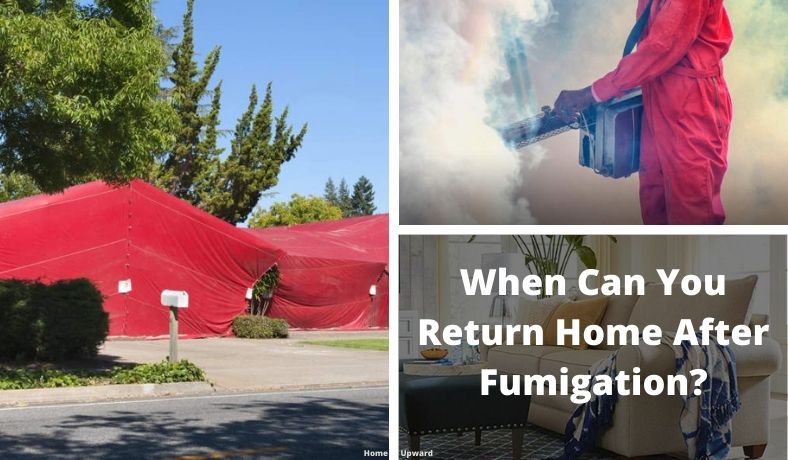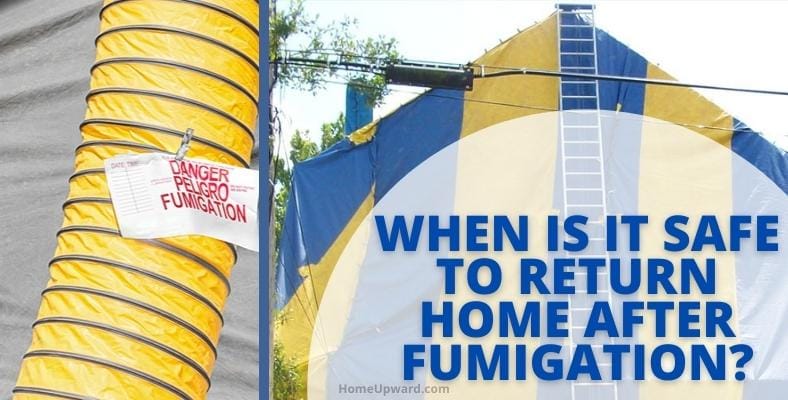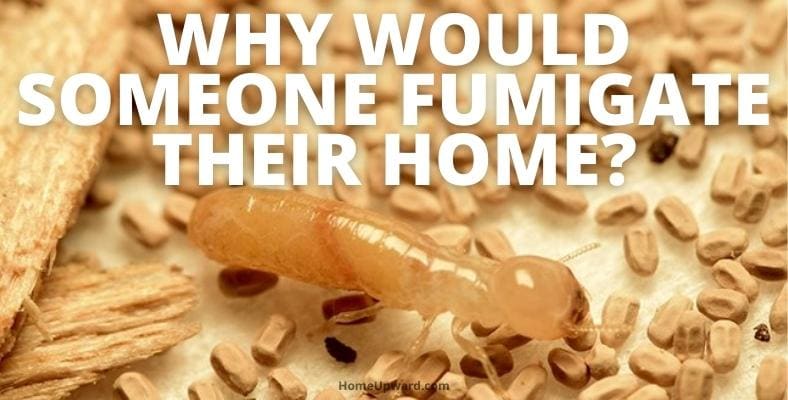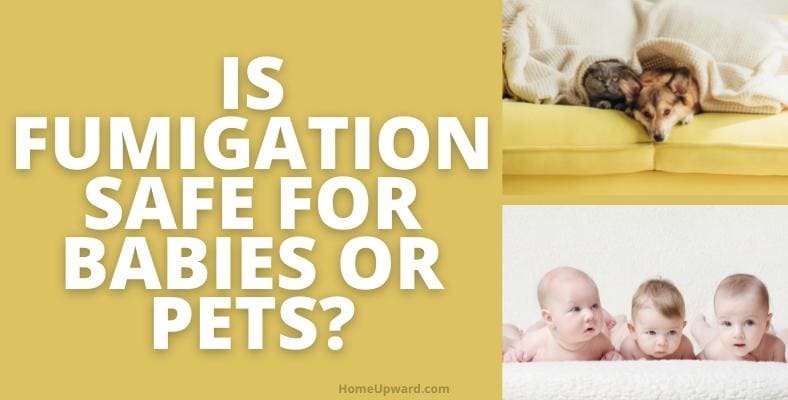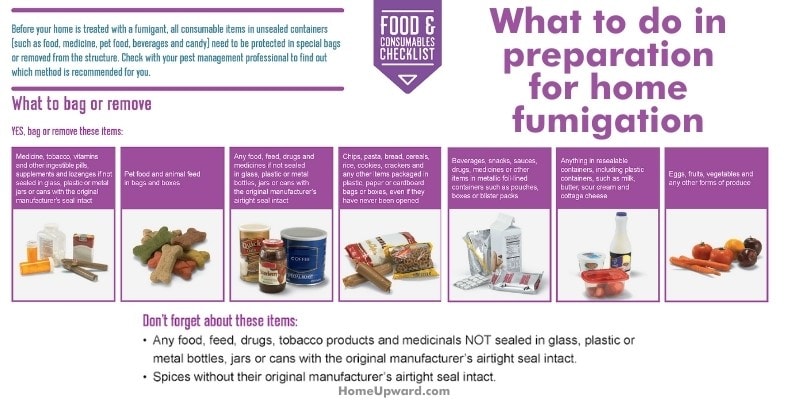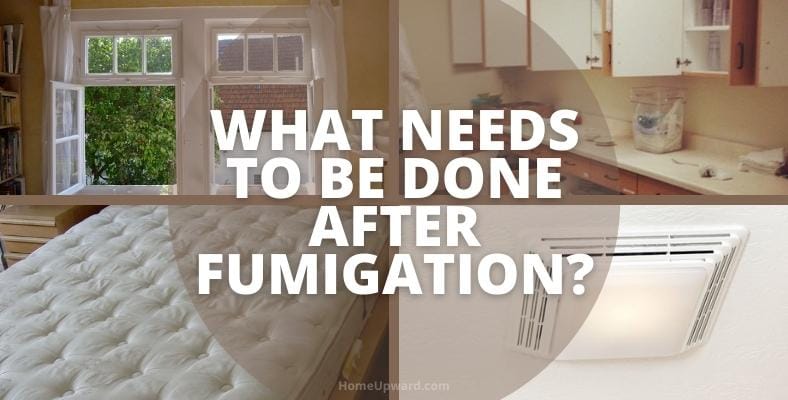If you’re having to deal with pest infesting your home, you may have learned how fumigation is a great way to get rid of them. I had a bad roach problem in an apartment I used to live in (thanks to former tenants, ugh!) and I had to fumigate the heck out of it!
But what is fumigation really, and how long after fumigation is it safe to return home? In this article you’ll learn when it’s safe to go back home – and a lot more.
Contents
When is it safe to return home after fumigation?
The amount of time it is safe to return home will depend on how severe the infestation is, the type of pesticide used, and where you live. This can be around 60 hours or so after the process starts (about 2 and 1/2 days).
Your pest control expert will use a gas analyzer machine (often called a “gas sniffer”) to see what levels of gas are within your home. No one can enter until the gas levels are below 1 part-per-million (1 PPM).
They will open a few doors, such as a hatch to the attic, garage door, or crawlspace access (if accessed internally.) If you have an HVAC or central air conditioning unit, they will turn that on and let the air blow to begin clearing the gasses from your home.
The average time after fumigation has finished that you can reenter the home is around 8 hours. However, the entire process goes to about 60 hours in total. Experts usually advise not allowing children or vulnerable people to enter the home for 24 hours after the inspector has reopened the home.
Why would someone fumigate their home?
One of the most common reasons someone’s home is fumigated is due to dry wood termites. These tiny pests can live for years on the cloth, flooring, drywall, and the internal structure of your home.
Fumigation occurs when a pest cannot be wiped out totally using traditional pest control methods. These are extreme cases when the pest has moved in so deep that spray or traps can no longer work.
A pest control specialist may suggest a series of visits before fumigation using spray pesticides before going for the full-tent process.
Because pesticides are so dangerous chemicals that can kill, business owners, homeowners, and renters alike are often opposed to fumigation. Fumigation kills plants, pets, poison humans, and even contaminate food.
Should I be concerned if my neighbor fumigated their house?
Because a particular type of tent is used, you don’t need to worry about the gasses escaping from the tent if your neighbor is getting their home fumigated. The tent’s purpose is to keep all those gasses inside, focusing on saturating the home and its internal structure.
The gasses used during fumigation are designed to kill any pests within, so any bugs within should not escape. However, if your neighbor’s home has been infested with termites or another type of pest, your house may be as well.
If you see your neighbor undergoing home fumigation, speak with a pest control professional to have a pest inspection conducted on your home.
Is fumigation safe for babies or pets?
The process of fumigation involves a lot of dangerous chemicals and pesticides. Therefore, it’s definitely not safe for babies, those with health conditions, or pets. It’s critical you make sure no living creatures remain in your home during fumigation or are exposed to leftover chemicals before it’s safe.
However, it is safe for babies, pets, and vulnerable people to return after your pest control professional has given you a certificate and go-ahead for going home again.
What to do in preparation for home fumigation
Here are steps you should take before fumigation occurs at your home.
Immediately after deciding to fumigate:
- Make arrangements for somewhere else to live while the fumigation is going on
- Schedule a shut-off for your gas
- Move any cars or moving structures away from the area
- Schedule a hold-mail service
2-3 days before fumigation occurs:
- Remove any unsealed food and medicine
- Confirm any necessary arrangements required by your pest professional
- Remove outdoor and indoor potted plants from within your home
- Prune or remove any plants touching your house
- Water around the foundation in an 18-inch circle
The day before:
- Water the soil again
- Open waterproof covers on furniture
- Notify your neighbors
- Ensure you have the restoration of utilities or gas scheduled
The day of the fumigation:
- Hand over the keys to the pest control company.
- Ensure all pets, plants, and people are out of the home.
- Turn off the AC and any automatic timers, such as sprinklers.
- Turn off any electrical, like computers, pet habitats, heaters, etc.
- Put off pilot lights (like in a hot water heater, etc.)
- Open the doors and drawers to cabinets and closets.
What happens during home fumigation?
The gasses used during home fumigation are poisonous to pets and humans, so you and your pets will need to leave the property during the process.
To begin, the fumigation service will tarp or tent your entire home. They will tape or seal any slats and ventilation holes to ensure your home is completely sealed up within the tent.
Next, a thorough check of the property will occur to be sure that no humans, pets, or other occupants are within the home. The experts leave the tent and begin the fumigation process.
Using a particular type of machine, the pesticide fumes are pumped into the tarp. The gasses seep into the upholstery, carpet, wood, drywall, and any other item within your home that the pest may have been hiding within.
The chemicals are left to do their job for 24 – 72 hours, depending on the type of pesticide used.
The expert will ensure the gasses have been blown off, and the tent will be removed. After removal, they will do another manual check of the property to ensure the infestation has been taken care of. Also, follow-up treatment may occur.
Fumigation is often not a one-time fix solution – often, continued pest control will be needed.
What kind of infestation needs home fumigation?
Fumigation is often needed when very stubborn, particular pests have taken over a home, and standard pest removal techniques can’t work.
Fumigation is only used during specific types of infestations, such as:
- Drywall termites
- Powderpost beetles
- Severe rodent infestation
- Bed bugs (as a final extermination method)
Fumigation is rarely the first choice for an experienced pest control company.
Why does the gas need to be off for home fumigation?
When preparing for your fumigation, your pest control company will give all adult occupants an information sheet that details preparations, safety precautions, and potential health risks.
Edibles without an airtight seal will need to be removed or well sealed in a special bag. Any type of flame, such as an electric heating element or pilot light, will need to be turned off.
This is because pilot lights serve as an ignition source. The spraying of the pesticide gas could cause an explosion or other fire-related incident. Even some refrigerators and thermostats may need to be turned off before fumigation.
Speak with your pest control company for a full list of appliances that should be turned off or unplugged before fumigation.
Other essential home fumigation tips
Here are a few important tips to ensure your home fumigation goes as smooth as possible:
- Don’t get extra food.
- If something was in the fridge or freezer, it will be fine if it had been sealed in Nylofume bags.
- Leave windows and doors open when returning to the home for at least 30 minutes.
What needs to be done after fumigation?
Once you are cleared to go home, do not immediately go in and stay within the structure. After the all-clear, take these steps to stay safe:
- Do not bring any small children or pets back into the home immediately. If you or a loved one has any medical issues, do not be the first one into the house. Ask your pest company to complete the following steps.
- Once the green light has been given, go in and open everything. Open all the windows, open the doors, and remove all tape or plastic covering the company has used to seal the home.
- Do not leave any door closed. Open all of the closets, even in bedrooms. Open cabinet doors, closet doors, bedroom doors, etc.
- Do not immediately get into bed. Remove all bedsheets, coverings, etc. from furniture and put those into the washer.
- If you have vents, such as oven vent or bathroom fan, run those for at least 10 minutes.
Do I need to clean after fumigation?
You should not need to wash dishes, etc. after fumigation.
However, if any food, pet food, or consumable product wasn’t protected or removed before the fumigation, you absolutely must not eat it. Dispose of any food that was left in the home and not sealed.

